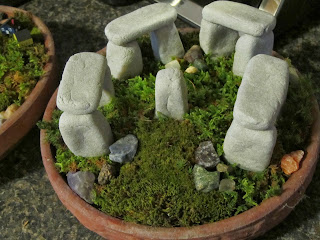The garden has been amazing..well for the most part. Our yearly complaint is slugs. I really can't believe how many we have. They seem to attack every seedling and are quite fond of the cabbage. An interesting discovery was that the salt in our fertilizer seemed to keep them at bay.
Here are our beets, leeks, and carrots. This picture is a couple weeks old. Since then the leeks have gotten bigger and we've picked and canned the carrots.
 |
| carrots, leeks, and beets |
|
The potatoes grew amazing as always. They are one of our best plants every year. Hubby planted a mix of red potatoes and russets this year. The red potatoes produced a lot more spud than the russets did. (Although the russets still grew well.) From now on I think we'll stick to red or white potatoes, they seem to do the best. Again, this picture is a couple weeks old. The plants are dying back now and I've started canning potatoes as hubby digs them up.
 |
| potatoes | |
The patty pans, zucchini and yellow squash are other great growers. (you can see them in the back left of the potato picture) I'm impressed with the size those plants get to, nearly 4 feet. (I'll have to get a picture of them) Unfortunately my pickling and slicing cucumber have gotten hit with fungus shortly after they really started to produce. Fungus seems to be another problem we have and I think we'll have to get varieties that are more resistant to it. The patty pans are showing signs of it as well. Thankfully I was able to get a bunch of refrigerator pickles made. Even
though the plants are still producing I don't know how long they'll
last.
We accidentally planted gourds inside the garden. (it was suppose to be mini pumpkins) They have taken over a corner of the garden but, on the bright side, are producing some very nice gourds.
 |
| harvest of cucumbers, mini pumpkins, cabbage, patty pans, zucchini, yellow squash, beets and potatoes. |
|
|
Another complaint is the darn deer. I attempted to plant "jack be little" pumpkins, butternut squash, gourds, and sunflowers on the outside of the garden. Everything grew great until the deer found them and started feasting on them. Luckily Hubby sent a few of the butternut and pumpkin vines into the fenced garden where they can be protected so I will get some production off of them. Also I had a few potted pumpkin plants that I put into the garden as Hubby pulled potatoes and freed some space.
The only thing that saved my sunflowers is the fact that they're 10 FEET TALL!
...aren't they amazing!? They have no leaves up about 4 ft (thanks to our friends, the deer), and the gourds and pumpkins planted behind them hardly have any leave on them. However, I will manage to get a dozen little pumpkins off of them. This is my first year growing sunflowers and I am loving the size of these big guys! I think I'll be growing them again.
The hoop has been absolutely amazing! We've enjoyed it so much that we're planning to put another one (even larger) up next year. We don't have the issues with slugs and fungus that the outside garden is susceptible to. The plants are protected from heavy rain (so no fungus) and being closed in keeps the slugs from getting to our plants.
The jungle in this picture is our tomatoes that have reached up to the ceiling! Large slicing tomatoes are on the left and cherry tomatoes are on the right. Behind them are peppers, eggplant, watermelon, and cucumbers.
My eggplants are doing well. When we planted them out in the garden last year the plants were half this size and I got a handful of tiny eggplants.
 |
| eggplant |
These pepper plant are about 4 feet tall and COVERED in blossoms. Last year, planted in the outside garden, I had tiny 2 foot "bushes" that never produced a single pepper.
 |
| peppers |
I'll get some picture of the watermelon soon. We've found about a dozen melons but the plants are so thick it's hard to find them all. Into September we'll be pulling a lot of these plants to start our fall garden in the hoop. Potentially having fresh veggies into late fall and early winter will be great if all goes well!!



















































